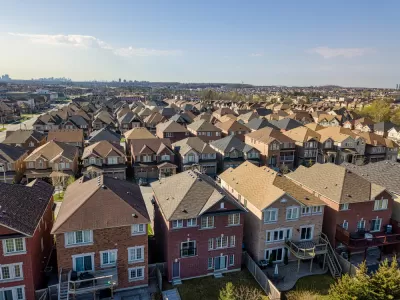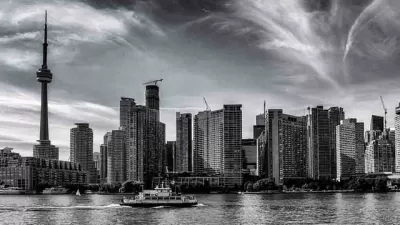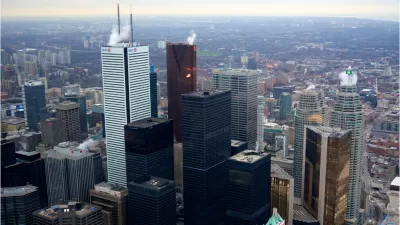The architecture critic for the Globe and Mail finds fault with two massive development proposals in the Toronto suburbs.

Alex Bozikovic, architecture critic for the Globe and Mail, writes about what he calls "a bit of Hong Kong in the 905"—the conceptual renderings for two new 'transit-oriented communities' in the Toronto suburbs of Richmond Hill and Markham.
"Drawings show forests of shimmering, skinny towers dropped into a flat suburban landscape," according to Bozikovic (see the renderings at the source article), and some local residents see a 'wasteland.'
While acknowledging the decidedly NIMBYesque flavor of the local opposition, Bozikovic writes "But in this rare instance, they’re right."
Bozikovic offers that frank assessment while also acknowledging the sound logic behind the proposal: "Put people near transit, and they will take transit rather than drive. And when you put enough people together, they can support retail and other amenities within walking distance."
So what goes wrong with the current proposal? According to Bozikovic the plan stretches that logic "to absurdity."
The High-Tech site would include 33 towers with 21,000 homes, plus retail and enough offices for about 7,000 jobs. One single block there would include three towers of 60 storeys and three of 80 storeys. The Bridge plan is comparable. Parks are thin. There are no schools. This would be one of the densest clusters of development in the entire region.
Bozikovic wrote an article in February 2020 that repeats similarities on the theme of how challenging it can be to build an urban suburb from scratch—and there are examples in the Toronto region, in Bozikovic's opinion, of failed attempts.
FULL STORY: With Doug Ford’s development plans for Toronto suburbs, sometimes big is too big

Study: Maui’s Plan to Convert Vacation Rentals to Long-Term Housing Could Cause Nearly $1 Billion Economic Loss
The plan would reduce visitor accommodation by 25,% resulting in 1,900 jobs lost.

Alabama: Trump Terminates Settlements for Black Communities Harmed By Raw Sewage
Trump deemed the landmark civil rights agreement “illegal DEI and environmental justice policy.”

Why Should We Subsidize Public Transportation?
Many public transit agencies face financial stress due to rising costs, declining fare revenue, and declining subsidies. Transit advocates must provide a strong business case for increasing public transit funding.

Paris Bike Boom Leads to Steep Drop in Air Pollution
The French city’s air quality has improved dramatically in the past 20 years, coinciding with a growth in cycling.

Why Housing Costs More to Build in California Than in Texas
Hard costs like labor and materials combined with ‘soft’ costs such as permitting make building in the San Francisco Bay Area almost three times as costly as in Texas cities.

San Diego County Sees a Rise in Urban Coyotes
San Diego County experiences a rise in urban coyotes, as sightings become prevalent throughout its urban neighbourhoods and surrounding areas.
Urban Design for Planners 1: Software Tools
This six-course series explores essential urban design concepts using open source software and equips planners with the tools they need to participate fully in the urban design process.
Planning for Universal Design
Learn the tools for implementing Universal Design in planning regulations.
Smith Gee Studio
Alamo Area Metropolitan Planning Organization
City of Santa Clarita
Institute for Housing and Urban Development Studies (IHS)
City of Grandview
Harvard GSD Executive Education
Toledo-Lucas County Plan Commissions
Salt Lake City
NYU Wagner Graduate School of Public Service





























